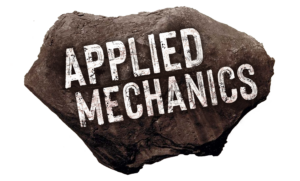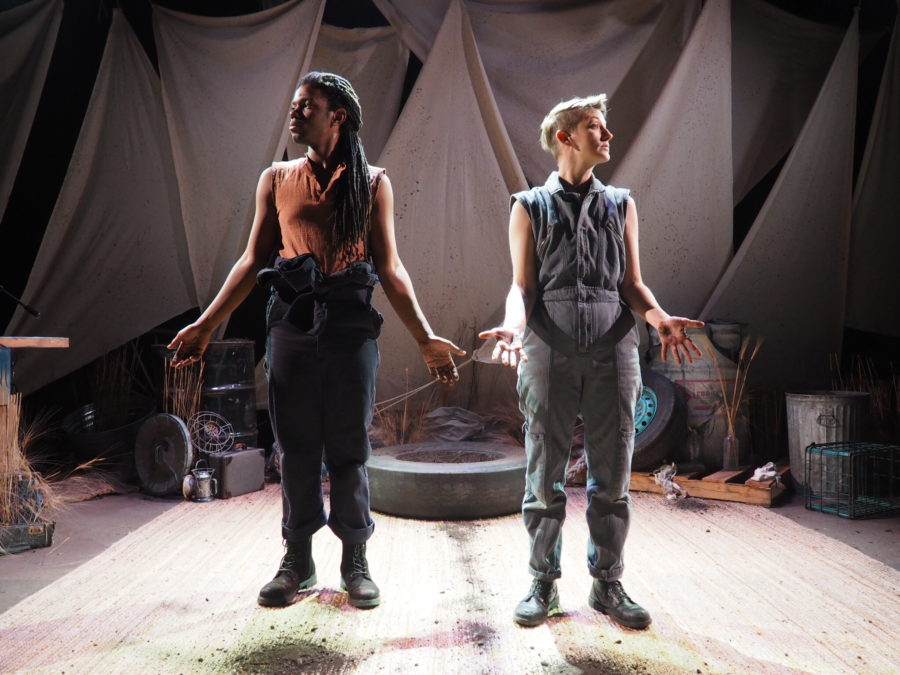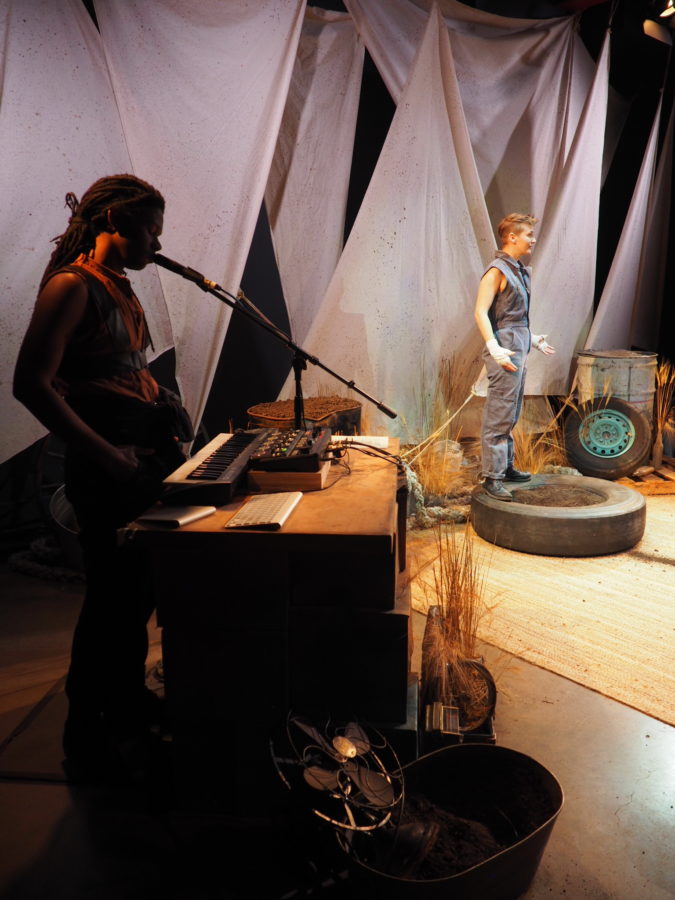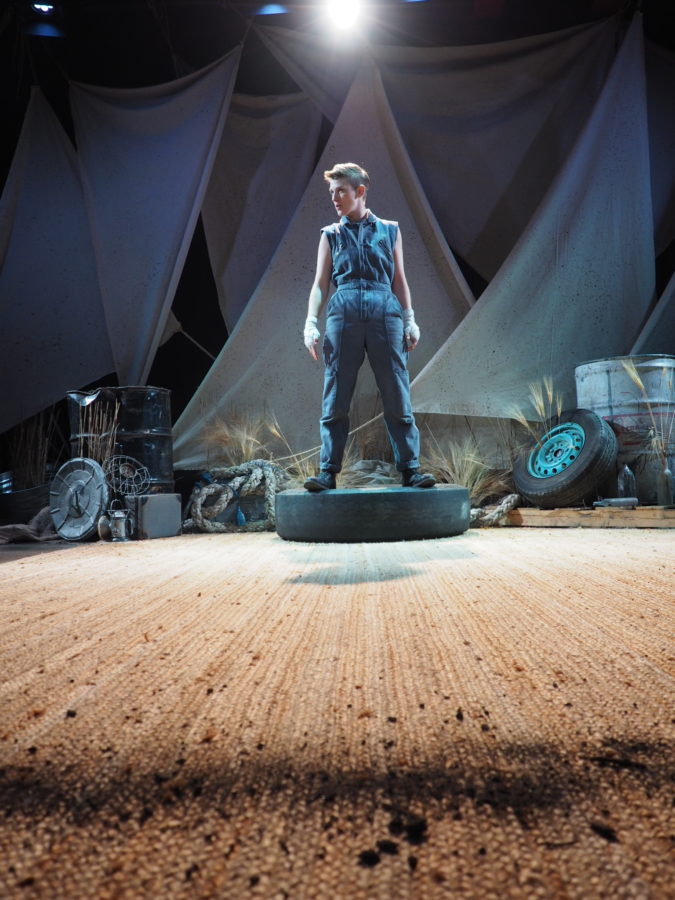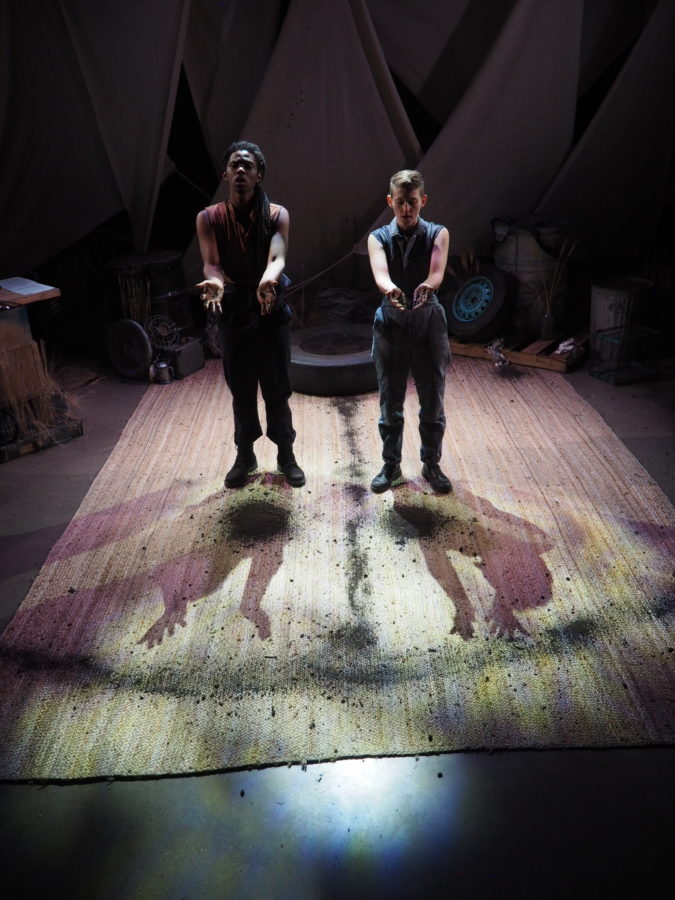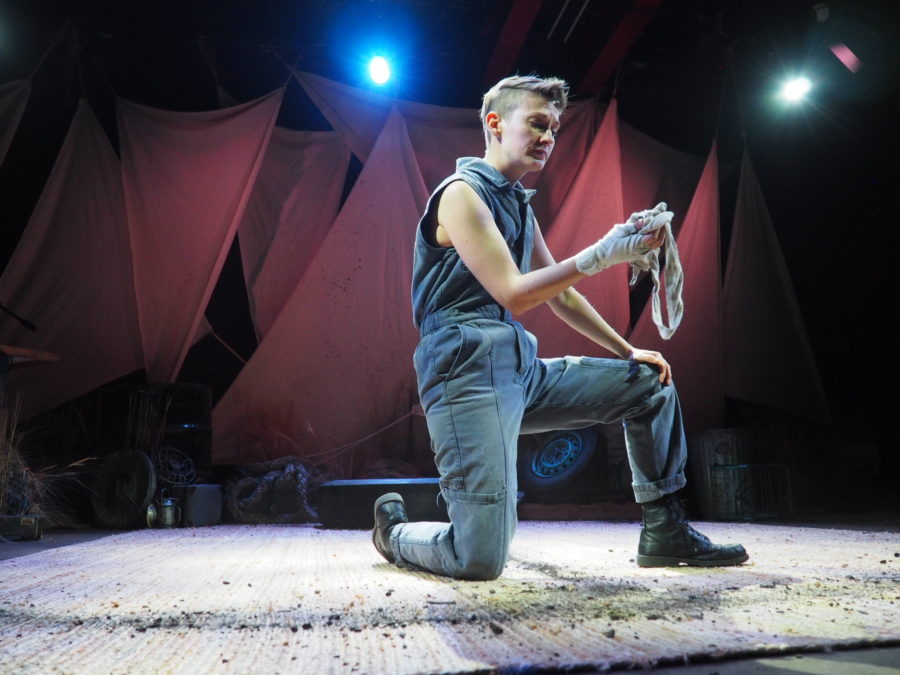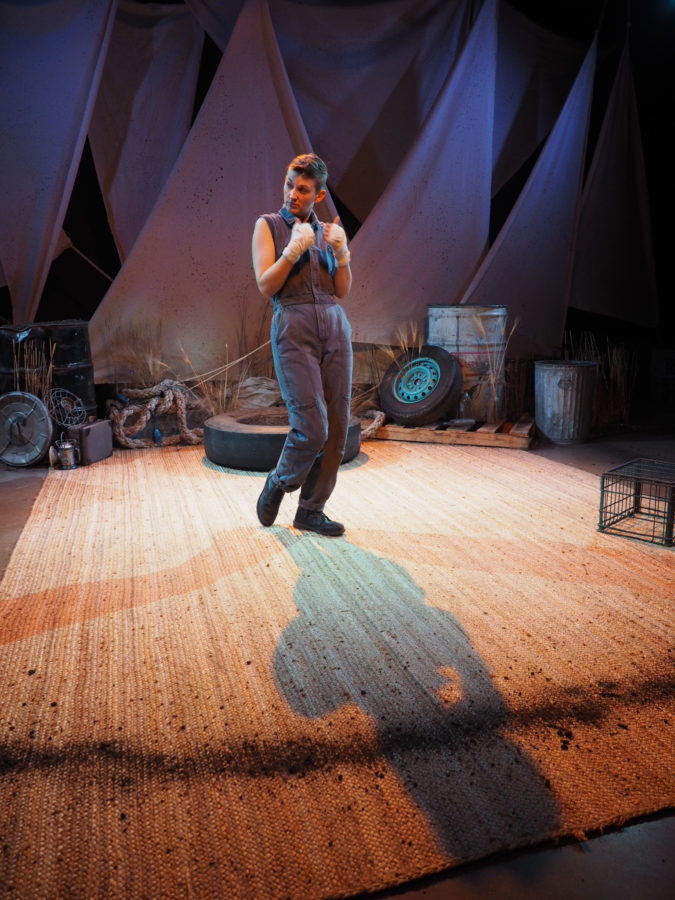Applied Mechanics’ superstars Mary Tuomanen, Rebecca Wright and Maria Shaplin have spent the last month rehearsing and teching An Iliad at The Arden. It just opened on Wednesday, and you can catch it until December 15th. Mary T and Jordan McCree perform, Becky directed, and Maria did the lights. Applied Mechanics Associated Artist Bayla Rubin assistant directed and is Mary’s understudy! Audiences seem to enjoy the heck out of it, and the process of making it was a pleasure for all folks involved. We asked Becky, Mary and Maria to answer some questions about An Iliad:
1. When you first read An Iliad, what jumped off the page? What was “hot” for you, and what aspects of the script felt out-dated or in need of an Applied Mechanics-stylistic overhaul?
Becky: I honestly found the script to be a pretty hard read. The main thing that jumped off the page for me were the stage directions, which are all things like “he rifles through his suitcase,” “he takes a drink,” “he washes his hands in the sink.” These did not jump off in a good way, but rather in a “oh no, we have to get rid of those” way. There’s also a lot of focus on male rage–as if wars happen because dudes just get so mad–and on the betrayal of unjust wars happening even when lots of good people don’t want them too. The first feels like a gross misinterpretation, the second like a pretty stale shock at this point. To both, I say, the more contemporary lens is that wars happen because certain powerful factions profit from them–whether we’re talking governments or CEOs, there’s money at stake, and no one cares about what lots of good people want when there’s money at stake. This is what motivates nations to send generations of young people to die, to destroy entire cultures, to perpetuate atrocities, to aggress. But the script doesn’t really share this lens at all. So it seemed dated and strange and very masculine and kind of “not radical enough” to me on first read, but here’s the thing: I love starting a project from the place of puzzles. I always have more questions than concepts when I first embark on a process. And I’d rather be bringing these questions and puzzles to my collaborators than a clear roadmap of where we’re going and how we’re going to get there. That way, everyone gets to be involved in creating the world, the map, the aesthetic, the meaning. In this case, it was an additional extraordinary gift to know I was heading into that conversation with so many Mechanician brains. Puzzling things out with longtime tried and true collaborators, who share your values and who you know will push you really hard, is one of the best things about my job.
Mary: I read this play years ago and immediately sent it to one of my male friends. He’s a Marxist actor who actually looks like Carl Marx and plays him all over the country, Bob Weick. I said, “this seems like a play for you!” It never occurred to me that a young female-presenting person like me would do this role. But the fact that I sent it to one of the most radical people in my life when I read it means I knew there was some political potential in this play. Towards the end of the show there is a 4 page list of wars. Performing it changes the contract with the audience. It turns what is more or less a standard solo show into a piece of performance art, briefly. It comes without warning, they are not prepared. You can feel it — the audience shifts in their seats, they sometimes murmur to each other, “Oh shit, is this person really gonna do this?” And yes. For three minutes, they sit there and listen to me meticulously list off over a hundred wars in chronological order. It’s a bold move in terms of artistic form, calculated to make everyone want to put their hands over their ears and yell, “STOP!”
The Arden asked me to come in and read it just with a few members of their artistic staff, at a table. I thought, “well, they’ve got the wrong guy for this, but I think they’ll figure that out when we read it.” This reading had the exact opposite effect; I looked up from the script into nodding faces and I was very shocked. The play is written for someone like my Marxist friend Bob — an older male body. I was unsure, even going into rehearsals, how we were going to transform the piece to fit me. There are also some pretty casual mentions of rape and women as property or spoils of war, which I obviously can’t speak aloud in a serious manner. In our overhaul of An Iliad, we stop the play for a little ritual where I pour out dirt, then smear the dirt on my costume to highlight the one line, “They take the girl to Agamemnon’s tent.” We give that event a bit more weight than the text alone affords it.
Maria: I admire An Iliad’s attempt to pay homage to the form that these stories took- an oral tradition in which singers memorized a vast number of stories of both surprisingly large scale and microscopic detail. It was a trip watching Mary memorize these densely-worded sections of text… she really doesn’t get a break for 70 minutes! Totally epic. I also enjoy that her character repeatedly calls upon the muses to help her build and access a grand memory palace. This recurring muse motif is a reminder that storytelling and performing are inherently creative endeavors that require you to use your imagination. As far as an overhaul, what I immediately knew that our production would toss was the script’s call for the actor to drink lots of whiskey throughout the play. Dude drinking in a room to access his emotions- It’s a very dated and shallow trope. This slow descent into drunkeness to facilitate the narrator’s channelling of Achilles and Hector’s extreme and vainglorious rage… it paints a dangerous picture- one that relinquishes responsibility for the violence that these men perpetrated when you “blame it on the a a a a a alchohol… ya know?
2. What are some of the most memorable moments from the rehearsal room/process?
Becky: The whole process was really so lovely. There was the day Jordan brought us all macarons from ICI, that was awesome. The day that he and Mary made this cool battle rhythm on their bodies that we ended up incorporating into the show. The day we spent a few hours watching boy band videos so we could work out a cool dance for Paris. The day we figured out that playing the song that Jordan wrote, Where Do the Old Gods Go, backwards would work well for the death sequences. There were really so many highlights. I loved working on this piece with these people.
Mary: Our musician Jordan McCree is incredible and we didn’t have to work very hard to make this show a duet rather than a solo, which was exactly what we wanted. Most of Applied Mechanics work, and even work we make together outside of the company, drives home the point that individual heroes aren’t as interesting as relationships. PEOPLE are interesting. What happens between people is interesting. And groups of people, not individuals, can change the world. Jordan is an incredible partner in all of this, speaking through his thoughtful music but also literally speaking text sometimes, coming out to perform small bits of movement with me, actually making this show a pas de deux, which feels right. There’s a love story in the middle of the Iliad between Achilles and Patroclus, and having both our bodies onstage drives that image home — comrades, lovers, the engine of mourning and revenge.
Maria: Watching Mary make the boy-band-inspired dance for the character of Paris. Completely hilarious.
3. If you could gush for a moment about a few of your non-Applied Mechanics collaborators on this project…..
Becky: Jordan McCree is a gem and a mensch. He had such a major hand in shaping the world of the play, and was so down to dive in with us headlong from the start to puzzle things out. I love the music he wrote and the ways he was able to balance sound made in the room with sound pre-recorded, incorporate discoveries we made together into his work, and flesh out a soundscape perfectly attuned to the action and live performed. He is really an incredible performer and a serious artistic force, all while maintaining the sweetest, chillest, roll with the punches attitude in every rehearsal. I feel so lucky we had him on this project and can’t wait to work with him again. Jill Keys was also a total magic bullet for this production. I’ve worked with her before as a costumer a bunch, both in the context of App Mechs and on other gigs, so I already know her as an awesome collaborator, but her scenic work on An Iliad was exceptional–so inventive and sensitive, doing so much with so little, and really focusing the storytelling. I mean, honestly, the day she brought that big tire into rehearsal for us to play with was the day the logic of the staging really clicked into place for all of us.
Mary: Jill Keys makes us look so cool onstage with her fabulous costumes and set! Jordan and I look washed ashore amidst some dirty tires and oil drums, our clothes reminiscent of something from a fishing rig, or flight suits… behind us, shredded sails… it’s both evocative and specific. It communicates beauty amongst waste. And Bayla Rubin, a longtime Applied Mechanics collaborator and former company member, was both our assistant director AND our understudy. She performed the entire show perfectly in her understudy run the other day, an hour and a half of text, and I cried like a baby. A lot of her work is in this show, and she was so key in the creation of it. What a privilege, though, to have so much App Mechs people power on this team. We got to bring our values of Groupthink and community to a regional theater process and that feels like getting away with something awesome.
Maria: I’m a huge fan of the set and costume designer for An Iliad, Jill Keys. She’s a frequent collaborator with Applied Mechanics, so it is an ongoing collaboration, but she just really knocked it out of the park on this one. I knew she was good at props, but I didn’t know she could also effortlessly bust out a set design of this caliber. It was very fun to light. She also took the amazing production photos in this blog post!
